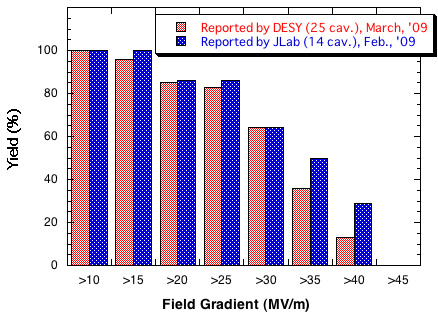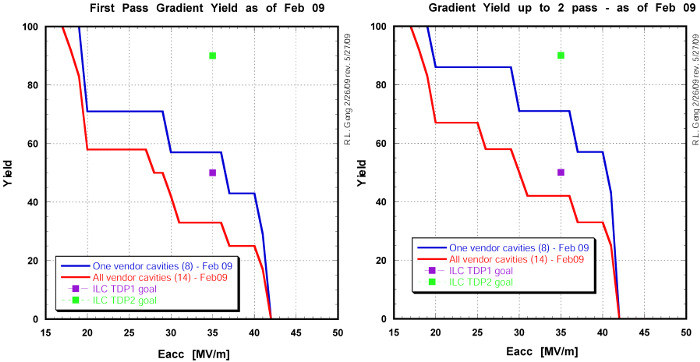Director's Corner
9 July 2009
 Barry Barish |
Improvements in high-gradient ILC SCRF cavities
Developing high-gradient superconducting radiofrequency (SCRF) nine-cell cavities is one of the primary goals of our global R&D programme. Soon after we initiated the Global Design Effort (GDE) R&D and design programme for the International Linear Collider, we set the ambitious goal of 35 Megavolts (MV) per metre as our gradient. If we succeed, we plan to set an average operating gradient of 31.5 MV per metre for the 14560 cavities mounted in the 1680 cryomodules of a 500-GeV ILC. Major efforts towards high-gradient cavities are underway in the Americas, Asia and Europe and we have recently made good progress that makes us believe our goals are within reach!
 Recent results on cavity yields from JLab and DESY approach our TDP-1 goal of 50% yield at 35 MV per metre Recent results on cavity yields from JLab and DESY approach our TDP-1 goal of 50% yield at 35 MV per metre |
We are taking a multi-prong approach towards developing a robust process for producing high-gradient cavities. We are trying in our own R&D programme to systematically understand and set procedures for the production process in order to make cavities from the materials by forming, welding and polishing. We have identified and are working to perfect many key issues, like problems with electron-beam welding, in order to transfer our knowledge to potential vendors. At the same time, we are trying to gain as much as possible from the world's expertise on superconducting RF technology, and for that reason we have approached the Tesla Technology Collaboration (TTC) for detailed advice.
This group initially formed around the Tesla Linear Collider effort at DESY, which was based on SCRF technology, and the TTC since then has become a worldwide collaboration with the mission “to advance SCRF technology R&D and related accelerator studies across the broad diversity of scientific applications, and to keep open and provide a bridge for communication and sharing of ideas, developments, and testing across associated projects. Besides other activities the TTC organizes regular collaboration meetings where new developments are reported, recent findings are discussed and technical issues are concluded.”
At the beginning of 2007 the ILC R&D Board Task Force on High Gradients (S0/S1) submitted a request for consultancy to TTC, seeking their advice on how to improve the yield, and they responded with a report late last year. Their suggestions, and our own developments as well, have enabled us to gain more understanding of the optimum procedures that have led to recent improvements.
What limits the gradient in produced cavities? There are several reasons why cavities do not reach high gradients. For example, we have been dealing with the problem of field emission over the past several years. Field emission causes an increase in the cryogenic load and/or dark current. Significant improvements have resulted from ethanol rinsing and ultrasonic cleaning with detergent. Much work continues and further reductions in field emission seem possible. We need to establish the acceptable field emission standards for vertical cavity tests and understand how this relates to performance for a cavity string.
Other reasons limiting the yield include imperfections on the finished surfaces. As a consequence, in addition to systematically understanding improving the process, we are also developing diagnostic tools to find and potentially fix flaws on the surface of the cavity. Two techniques that are being developed in the ILC R&D programme include temperature sensors at JLab and optical techniques in Japan. Such techniques open the possibility of selectively reprocessing cavities which have failed first-pass testing. We believe the key will be to optimise the process for first-pass production yield, and couple that with a data-driven decision to re-work or reject those that do not qualify. The re-working itself may take different paths depending on the diagnosis, some getting another high-pressure rinse, some being electro-polished again, etc. Our R&D programme on diagnosing the problems with failed cavities is aimed to help us develop an optimised re-work strategy.
Our stated goal is to reach a 50% yield at 35 MV per metre by the end of technical design phase 1 (TDP-1) in 2010, and we are already approaching that goal. We then have established the goal of 90% yield by the end of TDP-2 and much of the R&D presently underway is aimed at achieving that goal. We are also working to transfer the technical procedures to industry in order to be in a position to reliably and cost-effectively produce high-gradient cavities by the time of our Technical Design Report in 2012. Later this month, Akira Yamamoto, the GDE project manager for SCRF systems, will write the guest Director's Corner. He will give a more detailed account of our plans to move forward, which include providing a uniform prescription to analyse yield data and making a decision on the baseline gradient for the TDR.
-- Barry Barish

